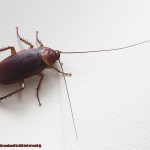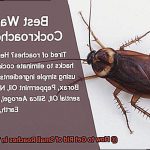Are you suffering from a roach infestation and looking for a solution? Have you considered glue traps as an option? This blog post will discuss whether or not glue traps are an effective way to get rid of roaches.
There are many products on the market for roach control, from sprays to baiting systems. Glue traps are pieces of cardboard or plastic coated with a sticky substance that captures any insect that passes through them. The idea is simple: the roaches get stuck and eventually die off.
But do they work? Let’s look at the pros and cons of using glue traps. On one hand, they can be very effective in trapping large numbers of roaches quickly.

Plus, they don’t require any special machinery or hazardous chemicals, making them safe for people and pets alike.
On the other hand, these traps don’t kill the roaches; instead, they just capture them until they starve or dehydrate to death. This means if you don’t dispose of them promptly enough, some may reproduce before dying completely.
So while glue traps can be a cost-effective way to trap many roaches at once, they may not be the best long-term solution due to their inability to kill existing populations quickly enough.
I’ll discuss more effective long-term solutions for tackling your roach problem in my next blog post.
Do glue traps work for roaches?
Contents
Glue traps are a popular choice for dealing with roaches, but do they work? The answer is both yes and no. On one hand, glue traps can be effective in trapping roaches, as the sticky surface is designed to capture them.
However, the effectiveness of glue traps depends on the type of roach and the size of the infestation.
For smaller infestations, glue traps can be an effective way to reduce the number of roaches. However, for larger infestations, glue traps may not be as effective as other methods.
When it comes to using glue traps for roaches, it is important to understand how they work. Roaches are attracted to the sticky surface of the trap, which then captures them when they attempt to cross it.

The trapped roaches can then be removed from the trap and disposed of. While this method can be effective in some cases, it is important to note that it does not always work. Roaches can sometimes escape from the trap or avoid it altogether.
To maximize the effectiveness of glue traps for roaches, it is important to use them in combination with other methods such as baits and insecticides.
This will help ensure that all possible sources of infestation are addressed and that the entire population is eliminated.
Additionally, it is important to regularly check and replace glue traps as they become less effective over time due to dirt and dust buildup.
The Benefits of Glue Traps for Roaches
Glue traps are an effective and affordable solution to get rid of roaches without endangering your family. They are non-toxic and safe to use around children and pets, making them ideal for households with young children. Plus, they can be placed in hard-to-reach places that other traps may not be able to access.
Setting up glue traps is easy and requires minimal maintenance. All you have to do is insert the glue trap in areas where you’ve seen roaches or where they like to hide. The sticky surface will attract the roaches, trapping them without using any harsh chemicals or pesticides that could be harmful to humans or pets.
Glue traps can also help identify the type of roach issue you have. Different species of roaches will be attracted to various types of glue traps, so it’s important to know which type of trap will be most effective for your situation. This will help you determine how to minimize the number of roaches in your house in the future.
If you’re dealing with a pesky roach problem, try using glue traps. They offer a fast and safe way to get rid of these critters without exposing your family to hazardous chemicals or pesticides.
How to Attract Roaches to Glue Traps
Glue traps are a great alternative! These traps use a sweet-smelling bait that is irresistible to roaches, luring them in and trapping them until they can be disposed of. Here’s a comprehensive guide on how to attract roaches to glue traps so you can get rid of those pests once and for all.
Select the Right Location
To ensure that your glue trap is successful, it is important to place it near areas where roaches are likely to be found. This includes dark corners, near food sources, and damp areas like bathrooms, kitchens, and basements.
Use the Appropriate Bait
Roaches have their preferences when it comes to food. To draw them into your trap, you can use essential oils such as peppermint or eucalyptus, or food-based baits such as peanut butter or honey.
Make It Accessible
Roaches will only be attracted if they can find your trap quickly! Make sure that the trap is placed in an area where they can easily locate it and get stuck on it before they have a chance to escape.
Check Regularly
To ensure that there are always fresh traps available for roaches to be attracted to, make sure you check on the glue traps regularly and replace them when necessary.
Consider Other Techniques
Although glue traps are effective at attracting roaches, they may not be strong enough on their own if you have a large infestation. In this case, you may want to try other techniques such as insecticides or baits to completely eradicate the disease from your home or business premises.
What Types of Roaches Can Be Trapped with Glue Traps?
Glue traps are an effective and humane way to trap different species of roaches without the need for harsh chemicals.
German cockroaches, American cockroaches, and Oriental Cockroaches are the most common types of roaches that can be trapped with glue traps.
However, it’s also possible to use glue traps to trap other species such as the Australian cockroach, Brownbanded cockroach, and Smoky brown cockroach.
To ensure the successful trapping of these pests, place the glue traps near food sources and water sources where roaches are likely to congregate.
Additionally, since roaches prefer dark areas, make sure you locate your glue traps in dark spots.
When it comes to particular species of roaches, the size of the glue trap should be taken into account as some species may require a larger or smaller trap depending on their size.
Are There Any Disadvantages To Using Glue Traps For Roaches?
Glue traps are a popular way of ridding your home of roaches, but they come with some drawbacks. For one, they can be a sticky mess to clean up. Not only that, but the residue left behind can attract other pests.
In addition, glue traps are not reusable; once used, you’ll need to replace them with a new one.
This can get costly over time. Furthermore, not all roaches may be attracted to the glue or find a way to escape from it. Lastly, non-target animals such as pets and birds may become stuck in the trap and suffer serious injury or death as a result.
For these reasons, glue traps should only be used as part of an integrated pest management plan.
While they may help catch some roaches, they should only be used alongside other methods such as sanitation and exclusion for long-term success in controlling roach populations.
Conclusion
Glue traps can be an effective, non-toxic way to manage roach populations in your home or business. They’re easy to set up and require minimal upkeep, plus they won’t harm children or pets.
However, it’s important to remember that glue traps are not a long-term solution; they won’t kill existing populations quickly and must be used responsibly to avoid any potential harm.
When used as part of a comprehensive pest control plan, glue traps can be a great way to keep roaches at bay. Just make sure you use them correctly and dispose of them promptly for the best results.






